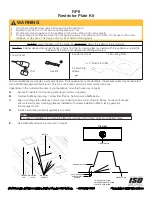
5
Use a hammer to strike the center of the 6” “knock-out”
disc from the outside of the stove. The “knock-out” disc
will break into four wedges and may need to be tapped
out. Touch up any remaining sharp edges with a file or
hand grinder.
Reinstall the top casting and front door with hinge
washer. Replace the rear heatshields and shield spacer
nuts. Remove the metal cover plates from the heatshields
and reinstall.
Reminder:
Reinstall the small nuts used as
spacers between the two heatshields. See
fig 2
.
Side-exit Venting
If venting through the side is desired it will be necessary
to remove the top casting. Using a 3mm allen wrench
remove the two set screws that secure to the top to the
side panels. Remove the front door to avoid damage to
the glass. Reminder: Loss of the door washer will result
in improper door alignment when reinstalling the door.
Using a claw hammer or a small sledge hammer strike the
center of the 6” “knock-out” disc from the inside of the
stove. The “knock-out” disc will break into four wedges
and may need to be tapped out. Touch up any remaining
sharp edges with a file or hand grinder. Reinstall the front
door, remembering the washer and the top casting.
Installing the flue collar
Place the self-adhesive gasket
(Fig.3A)
on the underside
of the smoke outlet
(Fig. 3B)
.
Mount the smoke outlet with use of the supplied screws
and cross bar
(Fig. 3C)
Secure the first section of stove pipe to the flue collar using
two sheet metal screws.
USA/Canada
Fig. 2
Spacer
Nuts
Heatshield with
listing label should
be installed on the
outside
Fig.3
Stove pipe - chimney connector
The chimney connector is a single walled pipe used
to connect the stove to the chimney. For use with the
Jøtul F
3
the chimney connector must be 6” in diameter,
with a minimum thickness of 24 gauge black steel.
Aluminum and galvanized steel pipe is not acceptable for
use with the Jøtul F
3
. These materials cannot withstand
the extreme temperatures of a wood fire and can give off
toxic fumes when heated.
Each chimney connector or stove pipe section must be
installed to the stove flue collar and to each other with
the male (crimped) end toward the stove. See
figure 4
.
Fig. 4
Crimped end installed
toward the stove
This prevents any amount of condensed or liquid creosote
from running down the outside of the pipe or the stove top.
All joints must be secured with three sheet metal screws
to ensure that the sections do not separate.
For the best performance the chimney connector should
be as short and direct as possible, with no more than two
90° elbows. The maximum horizontal run is 36” and a
recommended total length of stove pipe should not exceed
10 feet. Always slope horizontal runs upward 1/4” per foot
toward the chimney.
No part of the chimney connector may pass through an
attic or roof space, closet or other concealed space, or
through a floor or ceiling. All sections of the chimney
connectors must be accessible for cleaning.
f i r e - p a r t s . c o m






































